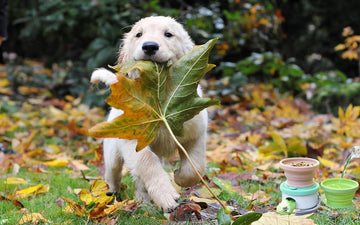Feeding a puppy can be a bit of a puzzle, but it’s essential for their health and development. Understanding how much to feed a puppy involves considering several factors including their age, weight, breed, and activity level. Puppies require different nutrients than adult dogs, and their dietary needs change as they grow. Here’s a comprehensive guide to help you navigate the feeding process.
Understanding Puppy Nutrition
Puppies have specific nutritional requirements that differ from adult dogs. They need a diet rich in protein, fats, vitamins, and minerals to support their rapid growth and energy levels. High-quality puppy food is formulated to meet these needs, providing balanced nutrition for development. It's crucial to choose puppy food that is designed specifically for their growth stage, as it includes the right balance of nutrients to foster healthy bones and muscles.
Factors Influencing Feeding Amounts
- Age: Puppies' feeding requirements change as they age. Typically, younger puppies need more frequent meals throughout the day, while older puppies can transition to fewer meals.
- Weight: The weight of your puppy plays a significant role in determining the quantity of food needed. Most puppy food packages provide feeding guidelines based on weight.
- Breed: Smaller breeds tend to mature faster than larger breeds, which affects their caloric needs. Large breed puppies require a specific diet to ensure healthy bone development.
- Activity Level: Puppies that are more active will require additional calories compared to those that are less active or more sedentary.
General Feeding Guidelines
For puppies, the general rule of thumb is to feed them three to four meals a day until they are about six months old. After that, you can gradually reduce it to two meals a day. Here are some guidelines to consider:
- Under 3 months: Puppies should be fed about 1 cup of high-quality puppy food per day, divided into three to four meals.
- 3 to 6 months: Increase to about 2 to 3 cups of food per day, split into three meals.
- 6 to 12 months: Depending on the breed, you may feed them 2 to 4 cups a day, divided into two meals.
Always refer to the specific puppy food package for recommendations, as calorie content can vary significantly.
Measuring Food Accurately
Accurate measurements are crucial for ensuring your puppy receives the right amount of food. Use a standard measuring cup to portion out their meals. Avoid using feeding bowls that don’t have measurements marked, as this can lead to over- or under-feeding. Investing in best dog feeders can also help in providing precise portions for your puppy, ensuring they get the right nutrients without overindulging.
Monitoring Growth and Weight
Regularly check your puppy’s weight and body condition. A healthy puppy should have a defined waist and be able to feel their ribs without excessive fat covering. If you’re unsure about your puppy’s growth or weight, consult your veterinarian. They can provide personalized recommendations based on your puppy’s health and development. Keeping a journal of your puppy's weight and growth can also help you track their progress.
Signs of Overfeeding or Underfeeding
Being observant of your puppy's behavior and physical condition can help you determine if you're feeding them the right amount. Here are some signs to look for:
- Overfeeding: If your puppy is gaining weight too quickly, becoming lethargic, or experiencing digestive issues, you may be overfeeding. Additionally, if they have difficulty exercising or playing, it may indicate excess weight.
- Underfeeding: Conversely, if your puppy seems overly hungry, is losing weight, or has low energy levels, you might not be providing enough food.
Choosing the Right Puppy Food
Select high-quality puppy food that meets the standards set by the Association of American Feed Control Officials (AAFCO). Look for a product that lists meat as the first ingredient, as this indicates a high protein content. Avoid foods with excessive fillers or artificial additives, as these can lead to nutritional deficiencies.
Hydration is Key
Don’t forget that access to fresh water is just as important as food. Puppies are active and require hydration to maintain their energy levels. Ensure your puppy has constant access to clean water, especially after meals and playtime. Proper hydration supports overall health and helps prevent urinary tract issues.
Choosing the Right Dog Supplies
When feeding your puppy, consider investing in quality dog bowls that are appropriate for their size. Proper feeding equipment can make a significant difference in the feeding experience, ensuring that your puppy eats comfortably and safely. Non-slip bowls can also prevent messes during mealtime.
Transitioning to Adult Food
As your puppy approaches adulthood, typically around 12 months for small breeds and up to 24 months for large breeds, it’s time to transition to adult dog food. Gradually mix in the adult food with their puppy food over a week to avoid digestive issues. This careful transition will help maintain your puppy's digestive health and adapt them to their new diet.
Conclusion
Feeding a puppy requires careful consideration of their nutritional needs based on age, weight, breed, and activity level. By following recommended guidelines, measuring food accurately, and monitoring their growth, you can ensure your puppy receives the right nutrition for healthy development. Always consult your veterinarian for tailored advice and to address any concerns regarding your puppy's diet.
With these practices, you’ll not only provide your puppy with the right nourishment but also foster a loving and healthy environment for them to thrive.










